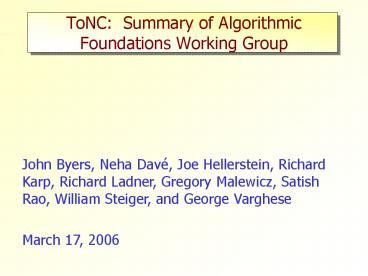ToNC: Summary of Algorithmic Foundations Working Group PowerPoint PPT Presentation
Title: ToNC: Summary of Algorithmic Foundations Working Group
1
ToNC Summary of Algorithmic Foundations Working
Group
John Byers, Neha Davé, Joe Hellerstein, Richard
Karp, Richard Ladner, Gregory Malewicz, Satish
Rao, William Steiger, and George Varghese March
17, 2006
2
Distinctive Network Attributes and Considerations
- Massive scale and scale-invariance
- Constraints space, memory, power, processing
- Streamed data continuous queries
- Heterogeneity of capabilities
- Graphs locally known, imperfectly known, or
hidden. - Evolving topology
- Networks increasingly under attack
3
Algorithms Within The Network Providing
Fundamental Functionality
- Routing
- Exploiting geometry, e.g. curveball routing
- Quantifying expressiveness vs. complexity
tradeoffs - Avoiding/mitigating route flapping and
oscillations - Approximately optimal routing compact routing.
- Load balancing and scheduling
- Impact of heterogeneity complex failure modes
- Economic considerations imperfect information
- Naming and lookup
- Data-centric lookup
- Intentional naming
- Specification and validation
- Rich routing semantics that are verifiable
4
Algorithms Within the Network Making the Network
Better
- Measurement and management
- Streaming algorithms
- Going beyond AMS and FM sketches
- Network self-analysis and correction (more next)
- Fault diagnosis
- Why button, detection of correlated failures
- Network coding
- Improving defenses, detection and forensics
- Algorithmic detection of outliers or patterns
- Construction of defenses that are hard to learn
- DDoS traceback, worm propagation traceback
5
Network Self-Analysis
- Given a time-evolving graph where
- Edge deletions and insertions are frequent
- Data arrives online, one-pass access
- Graph size may be prohibitive to store in its
entirety - Goal 1 Compute summaries/sketches of key graph
properties (conductance, bad cuts, eigenvalues). - Goal 2 Have the network take corrective action.
6
Networks as Objects
- Holistic approach operate on the entire network
- Universality, simulations, and embeddings
- Can GENI simulate an arbitrary network? (more
next) - Network growth and dynamics
- Model, measure, exploit!
- Codesign of network and algorithms
- Networks within networks
- Overlays, underlays, Grid, P2P
7
Universal Networks
- Can GENI simulate an arbitrary network with
different naming and routing conventions? - Can we embed a complex application or experiment
into a target infrastructure? Problem sketch - Multi-commodity flow problem
- Known traffic matrix
- Routes between ingress and egress nodes known
- Goal embed this application into the
infrastructure. - Minimize consumed resources, interference.
- Connects to key systems issues of virtualization,
emulation, repeatability of experimentation.
8
Lessons to Apply Going Forward
- Value of simple stripped-down models.
- Avoid pernicious effects of the ns simulator
- Lack of historical data has hindered validation
- Predict what we will need from GENI.
- Make sure to demand it, collect it!
- Diversity of processing elements communication
media - Indispensability of networks in society

